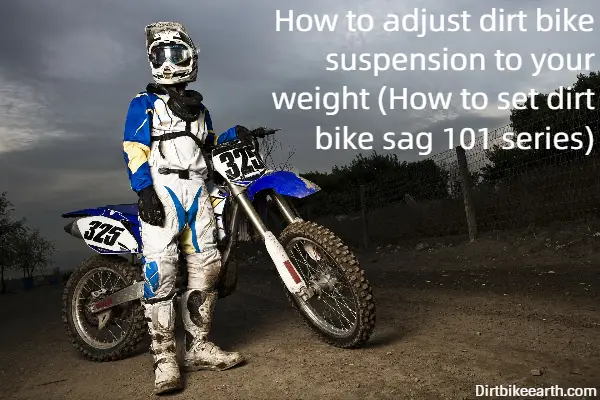
How to adjust dirt bike suspension sag
How to set sag on a dirt bike is often asked. Which is what this article aims to answer. Why is this question important? Well setting sag on a dirt bike is one of the most important things to do. But the question often asked is how do you adjust a dirt bike suspension to your weight. Let’s take a look for the rear suspension…
How to adjust dirt bike suspension to your weight and set sag:
- Measure your bike’s free sag, static sag and rider sag (race sag).
- If your weight is heavier than average: Shorten sag (i.e. tighten the shock lock nut and turn it clockwise).
- If your weight is lighter than average: Lengthen sag (i.e. loosen the shock lock nut and turn it anticlockwise).
What is dirt bike sag?
When we talk about sag, we are talking about how much your dirt bike “sags”. Or put another way, it’s how much your shock absorber compresses. This is either when the bike is sitting on the ground by itself under its own weight (static sag). Or when you are sat on the bike (rider sag or total sag).
Then there’s “free sag”, which is with the bike on a stand when the rear wheel is off the ground and there’s zero weight on the shock.
For most dirt bikes in the range of 250cc to 450cc, your sag will be in the region of 100mm (4″). The total travel on your rear shock’s going to have about 305mm (12″) of travel. Which means that rider sag of 100mm (4″0) will take up 1/3 of the total travel or 33.33%.
But always refer to your owners manual for the type and model of dirt bike you have. This will give you a window of what your sag should be for your dirt bike. Once you have your sag within the manufacturers “sag window“, you can fine tune it to suit your style of riding.
Why is dirt bike sag important to set correctly?
As I began this article, I said that setting sag on a dirt bike is one of the most important things you can do.
But why is dirt bike sag so important?
By setting your dirt bike’s sag correctly makes sure the balance of the bike is right. It will make sure your bike will handle the way you want it to and it’s going to make for safer riding too.
What does it mean to have more sag?
If you increase the sag, this means your rear end will sit lower. This will mean your dirt bike will be a little bit more stable at higher speeds.
More sag is better if you’re a desert racer.
What does it mean to have less sag?
If you have less sag, this means your dirt bike will steer and corner a bit better.
Less sag is better for tracks.
The dos and don’ts of dirt bike sag
I’ve included a few of the most important do’s and don’t of adjusting dirt bike sag in this article. But to see the whole list of do’s and don’ts please refer to this article: Full list of do’s & don’ts of adjusting dirt bike sag (Article in dirt bike sag 101 series).
- Always check rider sag with you on your bike so the the correct sag is set for your weight and preferred riding position. This should be measured with you in your complete riding gear and with your feet on the foot pegs and hands on the handle bars of the bike. But it should also be with at least half a tank of fuel too.
- Don’t adjust the sag on your dirt bike outside the “sag window“ recommended by the manufacturer of your bike. You can find this in your owner’s manual.
- Don’t check your dirt bikes’ sag when the suspension is hot: i.e. after you’ve ridden the bike, as it gets hot quite quickly. Heat build up will change the sag amount.
- Always measure to a fixed point on the bike when checking the sag to make sure you’re comparing “apples with apples” and not comparing “apples with pears”. It’s best to mark the fixed position you’re using with a marker pen or sharpie.
How to adjust dirt bike suspension to your weight
These are the steps to adjusting your dirt bike sag to suit your weight and riding position.
More Reading: Dirt bike suspension sag tools for the job (Article in dirt bike sag 101 series)
How to set sag on a dirt bike
There are three measurements you need to set sag on a dirt bike, which are:
- First is to measure free sag: Which is when your bike is on a stand and the rear wheel is off the ground.
- Second is to measure static sag: This is when the bike’s rear wheel is on the ground under its own weight only (i.e. no rider is sat on the bike).
- Third is to measure rider sag: Which is when you’re sat on your dirt bike with your feet off the ground and on the foot pegs. But note this should be done with your full dirt bike riding gear on.
Steps to set sag on a dirt bike:
- Bounce the rear suspension first to settle the static sag position: This helps to remove any stiction and settles the suspension to its natural position.
- Measure free sag: You need to put your dirt bike on a stand to do this so the rear wheel is off the ground. This is done using a tape measure or a folding sag scale. You need to mark a fixed point on the fender or mud guard with a marker pen or sharpie. This fixed point needs to be on the arc of travel of the back axle. Measure from the bolt of the back axle to the marked fixed point. If you’re using a tape measure make a note of the measurement on a piece of paper.
- Measure the static sag: Take your bike off its stand so it’s sitting under its own weight. Using the same marked fixed point, measure the new distance between the bolt on the back axle to the marked point. If you’re using a tape measure note the measurement on a piece of paper
- Get on your dirt bike: Get on your bike with your dirk biking gear on, including your safety helmet. Make sure to sit on the bike where you would when you ride. Sit with your feet on the foot pegs and your hands on the handle bars as if you’re riding the bike. Others say to stand rather than sit, which is also fine. This is where you’ll need the help of at least one friend, but preferably two. One to hold the bike steady and the second to measure the rider sag when you’re on your bike.
- Remove any stiction by bouncing on the bike’s seat: Bounce on the seat of the bike to stress the shock and to remove any stiction. This will allow the bike to settle to the correct and natural sag level or position. Then sit back down in the rider position.
- Measure rider sag: Using the same measuring tool as before, measure between the axle bolt and the same fixed point in two above. If you’re using a tape measure, make a note of the measurement on your piece of paper.
Calculating the sag of your dirt bike
- Deduct static sag from free sag: This will give you the static sag. Which is the difference between the measurement at two versus the measurement as three above. This should be somewhere between 30-40mm of sag for most big dirt bikes more than 250cc. But check your owners manual, as this will give you what this should be.
- Deduct rider sag from free sag: This will give you the rider sag. Which is the difference between the measurement at two above versus the measurement as six above. This should be around 100mm* (4″) depending on the bike and the type of riding you do.
- Adjust the sag if greater or less than 100mm* (4″): If the rider sag is more than 100mm* (4″), this is when you need to adjust this. See the next section on how to adjust dirt bike suspension sag to your weight.
Steps to take to adjust rider sag to your weight:
- If the rider sag is less than what it needs to be (i.e. less than 100mm* (4″) or what your owner’s manual says which could be in the region 95-115mm) you need to adjust the rear shock spring preload. This could mean you’re lighter than average.
- If the rider sag is more than what it needs to be (i.e. more than 100mm* (4″) or what your owner’s manual says) you need to shorten the spring on the shock. This could mean you’re heavier than average.
- On most Japanese made dirt bikes you’ll have two lock nuts. To adjust the sag on a Japanese dirt bike, first loosen the top locking nut. Do this using a screw driver, a punch tool or pre-loaded adjuster tool. On KTMs or Husqvarna dirt bikes you’ll have to loosen a pinch bolt using an Alan-key instead.
- Depending on whether you want to lengthen or shorten the spring, you need to either loosen or tighten the second lock nut. Or on a KTM or Husqvarna loosen or tighten what is usually a plastic lock nut once you’ve loosened the pinch bolt.
- Before you start to loosen or tighten the lock nut, mark one of the teeth or notches on the nut with your marker pen or sharpie. This will let you know when the lock nut has done a full rotation.
- Note that one full rotation equals between 2-3mm of sag adjustment.
- Once you’ve adjusted the shock adjusting nut, re-check your rider sag. Keep adjusting the nut until your sag is at the correct level for your weight.
- Re-check your static sag too, as this should still be around 30-40mm of sag.
To be clear when adjusting your dirt bike’s suspension to your weight in order to get the rider sag correct for your weight:
- Rider sag is too short and needs to be lengthened: Likely if your weight is lighter than average. If this is the case you need to loosen the second lock nut, which means you need to turn the nut anticlockwise with whichever tool you choose to do this.
- Rider sag is too much and needs to be shortened: Likely if your weight is heavier than average. If this is the case you need to tighten the second lock nut, which means you need to turn the nut clockwise with whichever tool you choose to do this.
- Note in both cases with KTM and Husqvarna: You’re not adjusting a second lock nut. There’s just one nut (usually plastic) that’s locked using a pinch bolt instead.
* Note: Rider sag can be more or less than 100mm (4″). This depends on the type of dirt bike you have, plus on the total available travel the bike has. If the total available travel is less than 305mm (12″), the rider sag will be less than 100mm. But if total travel is more than 305mm (12″), rider sag will be greater than 100mm. For this, check your dirt bike manual for your make of dirt bike.
What if rider sag is correct for your weight after adjustment but static sag isn’t?
There are two possibilities with regards to static sag after adjusting your dirt bike suspension for your weight. The first is that your static sag is too small after adjustment. The second is where the static is to much.
Rider sag correct for your weight but static sag is to short
If your rider sag is at the correct level, but your static sag is less than what your owners manual says it should be. Let’s say it’s at 20mm, This means you’ve put so much pre-load on the spring to support your weight (i.e. you’re a heavier than average). Which means you now have too little static sag.
To correct this you may need to install a harder spring.
Rider sag correct for your weight but static sag is to long
If your rider sag is at the correct level, but your static sag is more than what your owners manual says. Let’s say for example let’s say at 50mm. This means you’ve put too little pre-load on the spring because you must be smaller and lighter than average, which means you now have too much static sag.
To correct this you may want to look at getting a softer spring.
I hope you enjoyed this article about how to adjust dirt bike suspension to your weight
I’d love to hear from you. Tell us about your adventures of dirt biking in the comments below. Please also share your photos. Either from your cameras or videos from your Gopro’s!
If this article hasn’t answered all of your questions. If you have more questions about dirt biking (or specifically about how to adjust dirt bike suspension to your weight), please comment below with your questions.
There will also be many more articles about dirt biking for you to read and learn about this fabulous sport and hobby.
Have fun and be safe!




